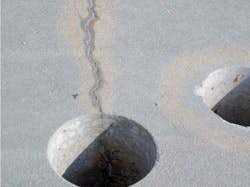Use of Epoxy-Coated Steel Reinforcing Bars Substantiated Thinner Pavement
Unlike plain jointed pavement or doweled jointed pavements, continuously reinforced concrete pavement (CRCP) is constructed without formed transverse joints. Transverse cracks then develop as the concrete shrinks during curing at a uniform spacing of 3 to 10 ft on center. CRCP utilizes continuous, lapped longitudinal reinforcing bars that provide restraint and hold the cracks tightly together. Epoxy-coated bars provide corrosion protection which results in a significant extension to the pavement life.
CRCP is especially applicable for transportation arteries of intense, heavy traffic and where the delays associated with repairs and rehabilitation have to be minimized. The first generation of interstate highway construction in the 1960s utilized pavements designed for 0.4 million ESAL (equivalent single axle loading) per design lane. Today, 2.5 million ESAL per design lane are anticipated.
CRCP RESEARCH
Following this CRCP investigation conducted at the Illinois Center for Transportation, it is anticipated that this design practice may be changed. The goal of this extensive investigation was to characterize the critical parameters that affect crack width of CRCP. The investigation included the construction of 10 heavily instrumented sections of CRCP followed by loading of the pavement. A new analytical model for cracks was developed and verified against the recorded measurements.
Critical parameters that affect the crack width of CRCP while loading the pavement to failure are:
- Percentage of reinforcing steel;
- Slab thickness;
- Concrete cover;
- The effect of uniformly induced crack spacing on performance; and
- The effect of utilizing two layers of reinforcing steel.
CONCLUSIONS
Most significant was crack width for ambient temperature, average temperature of the pavement and temperature differential between the top and bottom of the pavement. It was also found that the reinforcing steel adds significant strength to the pavement and may allow for less concrete depth in future specifications without loss of benefits. And the use of epoxy-coated steel reinforcing bars ensures corrosion protection from the undesirable effects of deicing salts and a much longer service life.
